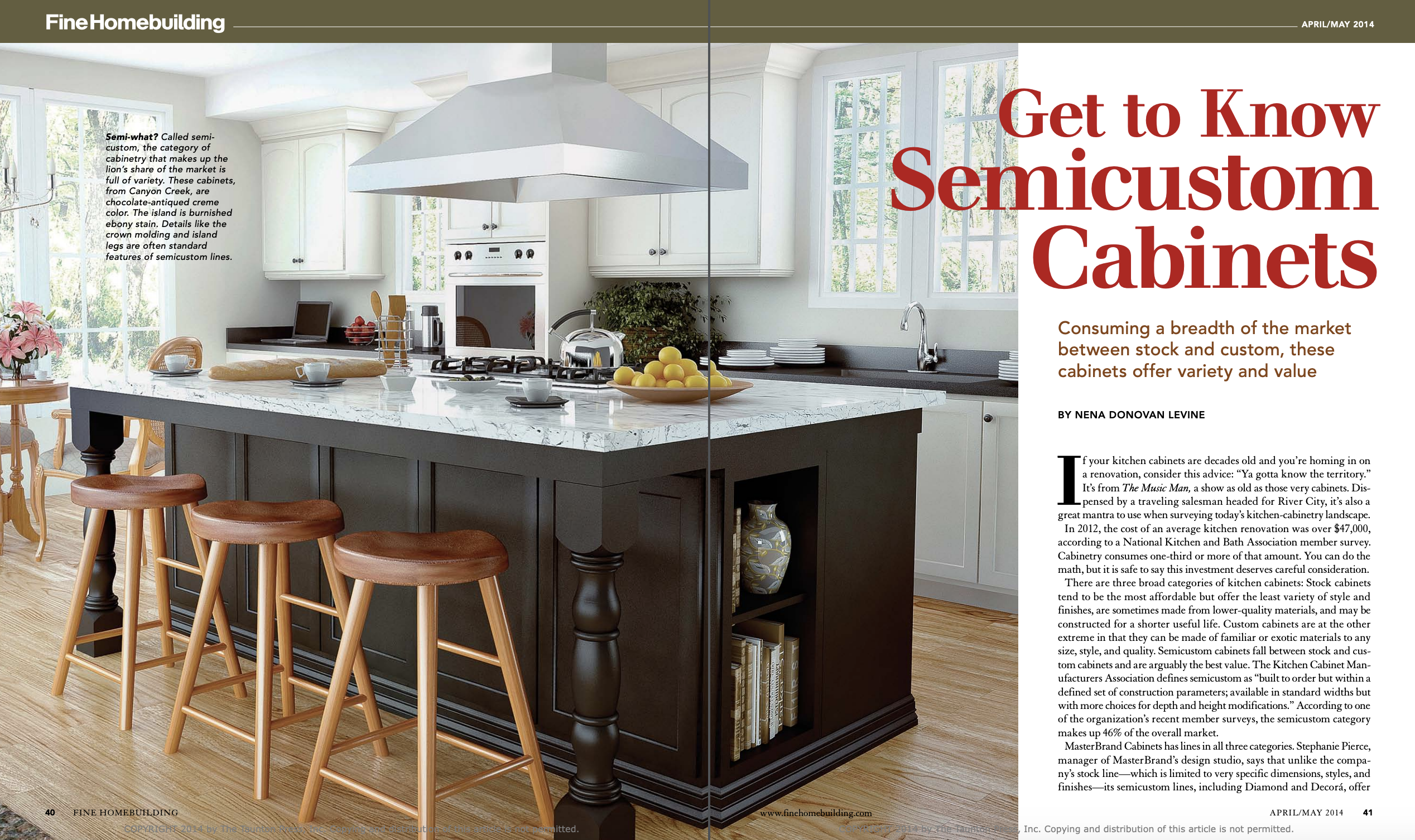Get to Know Semicustom Kitchen Cabinets
Consuming a breadth of the market between stock and custom, these cabinets offer variety and value.

Synopsis: Homeowners have three broad categories of kitchen cabinets to choose from: stock cabinets, which tend to be the most affordable but offer the least variety and are often made from lower-quality materials; custom cabinets, which are built to client specifications but are therefore usually the most expensive and require the longest wait for delivery; and semi-custom cabinets, which are built to order but from a more narrow set of options. In this article, designer Nena Donovan Levine explores the world of semi-custom cabinets, which constitutes the largest segment of the market. She covers the choice between face-frame and frameless construction, why it’s next to impossible to get an estimate of the cost of semi-custom cabinets, and why manufacturers have so many semi-custom lines. She discusses in detail the four elements that distinguish a quality semi-custom cabinet: box construction, drawers, doors, and finish.
If your kitchen cabinets are decades old and you’re homing in on a renovation, consider this advice: “Ya gotta know the territory.” It’s from The Music Man, a show as old as those very cabinets. Dispensed by a traveling salesman headed for River City, it’s also a great mantra to use when surveying today’s kitchen-cabinetry landscape.
In 2012, the cost of an average kitchen renovation was over $47,000, according to a National Kitchen and Bath Association member survey. Cabinetry consumes one-third or more of that amount. You can do the math, but it is safe to say this investment deserves careful consideration.
Stock, custom, and semi-custom
There are three broad categories of kitchen cabinets: Stock cabinets tend to be the most affordable but offer the least variety of style and finishes, are sometimes made from lower-quality materials, and may be constructed for a shorter useful life. Custom cabinets are at the other extreme in that they can be made of familiar or exotic materials to any size, style, and quality. Semi-custom cabinets fall between stock and custom cabinets and are arguably the best value. The Kitchen Cabinet Manufacturers Association defines semi-custom as “built to order but within a defined set of construction parameters; available in standard widths but with more choices for depth and height modifications.” According to one of the organization’s recent member surveys, the semi-custom category makes up 46% of the overall market.
MasterBrand Cabinets has lines in all three categories. Stephanie Pierce, manager of MasterBrand’s design studio, says that unlike the company’s stock line—which is limited to very specific dimensions, styles, and finishes—its semi-custom lines, including Diamond and Decorá, offer designers and builders “flexibility within limitations.” More specifically, these brands’ offerings can be customized only to the degree of the shops’ capabilities. At the custom end of the spectrum, Master Brand’s Omega Cabinets will outsource any fabrication that its shop is not capable of.
Snapshot of a giant category
Semi-custom cabinets are built upon receipt of an order, so lead time is longer than it would be for stock cabinets, which you can sometimes get off the shelf at a home center. It’s shorter than it would be for custom cabinets, however, although this varies based on the complexity of the cabinets and the builder’s availability. Merillat’s semi-custom Classic line can ship in as little as five to 10 days. Canyon Creek’s Katana line has a lead time as short as four weeks from order to delivery. Certain upgrades can push lead times out to six weeks or more.
Semi-custom cabinets are offered in standard 3-in.-wide increments from 9 in. to 45 in. For an upcharge, you can modify this to 1/8 in. Such precise dimensions reduce the call for filler strips and minimize wasted space. Standard cabinet depths and heights also can be increased or decreased for an upcharge. So if using a standard 24-in.- deep base cabinet doesn’t allow adequate clearance in a pantry or a passageway, you can reduce the box depth and still use the particular cabinets you were hoping for. Standard wall cabinets are 30 in. and 36 in. tall, but sometimes 33 in. or even 42 in. works better with a particular ceiling height. Again, with most semi-custom lines, this level of customization is possible.
For more photos and information on semi-custom cabinetry and how to access quality, click the View PDF button below.






